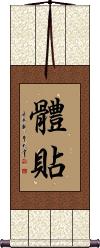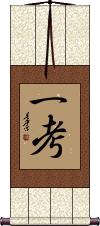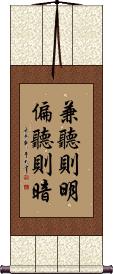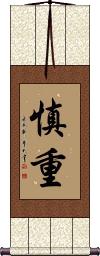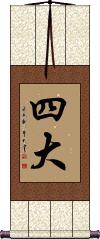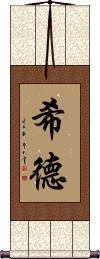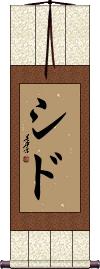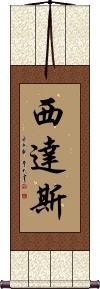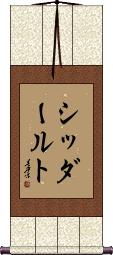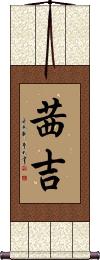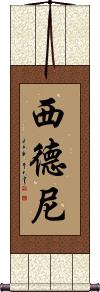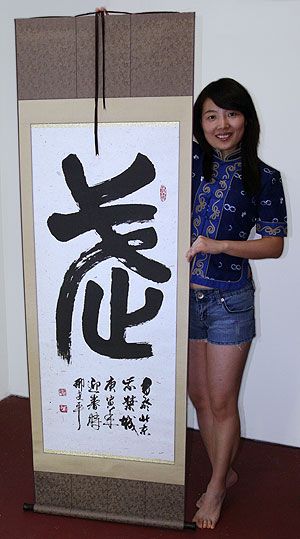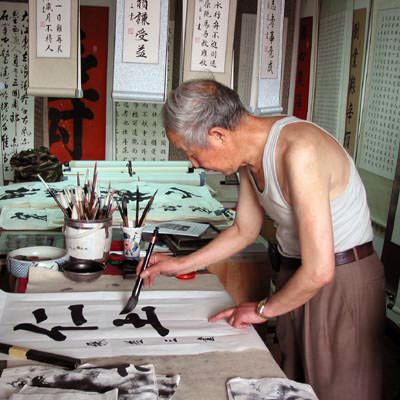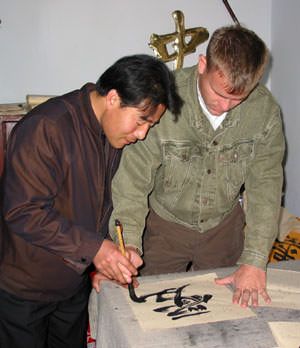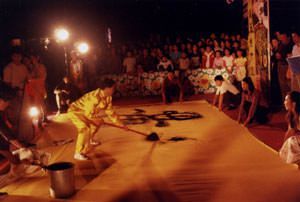The Name Sid in Japanese/Chinese on a Custom-Made Wall Scroll.
Click the "Customize" button next to your name below to start your personalized Sid calligraphy artwork...
Switched to secondary search mode due to lack of results using primary.
These secondary results may not be very accurate. Try a different but similar meaning word or phrase for better results. Or...
Look up Sid in my Japanese Kanji & Chinese Character Dictionary(My dictionary is a different system then the calligraphy search you just tried)
If you want a special phrase, word, title, name, or proverb, feel free to contact me, and I will translate your custom calligraphy idea for you.
1. Arsid
2. Cassidy
3. Chassidy
4. Considerate of the Needs of Others
5. Consideration / Meticulous Care
6. Desideria
7. Desiderio
8. Consideration / Thought / Ikko
9. Isidor
10. Isidoro
11. Isidro
12. Kassidy
13. Listen to Both Sides and be Enlightened, Listen to One Side and be in the Dark
16. Sid
17. Siddarth
18. Siddharth
19. Siddhartha
20. Siddik
21. Siddiq
22. Siddique
23. Siddiqui
24. Sides
25. Sidhu
26. Sidjy
27. Sidney
28. Sidonie
29. Sidrit
30. Whiteside
31. Woodside
Arsid
Arsid
Cassidy
Cassidy
Chassidy
Chassidy
Considerate of the Needs of Others
Consideration / Meticulous Care
Desideria
Desideria
Desiderio
Desiderio
Consideration / Thought / Ikko
Isidor
Isidor
Isidoro
Isidoro
Isidro
Kassidy
Kassidy
Listen to Both Sides and be Enlightened, Listen to One Side and be in the Dark
兼聽則明偏聽則暗 is an ancient Chinese proverb about getting all the information from all sides so that you truly understand a situation.
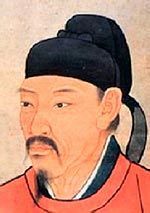
Wei Zheng
A man named Wei Zheng lived between 580-643 AD. He was a noble and wise historian and minister in the court of the early Tang Dynasty. The emperor once asked him, “What should an emperor do to understand the real-world situation, and what makes an emperor out-of-touch with reality?”
Wei Zheng replied, “Listen to both sides and you will be enlightened; listen to only one side and you will be left in the dark.”
Then Wei Zheng went on to cite examples of leaders in history that were victorious after heeding both sides of the story, and other leaders that met their doom because they believed one-sided stories which often came from flattering lips.
Please note that there is an unwritten rule when the same character appears twice in the same phrase, the calligrapher will alter the appearance so that no two characters are exactly alike in the same piece. This calligraphy has two repeating characters that will be written differently than they appear here.
Prudence / Considerate
慎重 conveys the idea of being considerate, having prudence, and being thoughtful when taking action.
慎重 can also mean cautious, careful, discreet, deliberate, or taking all things into consideration.
The general meaning is shared across languages. However, in Chinese, this is more about prudence, while in Japanese, this is more about being considerate.
Chinese Catholics use this word to represent “prudence” in the list of the Seven Heavenly Virtues.

![]() Note: Depending on your choice of Chinese or Japanese calligraphers, the first Kanji will vary slightly.
It is technically the same character. Japanese tend to leave a space between the upper and lower portions of this particular Kanji. See sample images to the right.
Note: Depending on your choice of Chinese or Japanese calligraphers, the first Kanji will vary slightly.
It is technically the same character. Japanese tend to leave a space between the upper and lower portions of this particular Kanji. See sample images to the right.
See Also: Moderation | Modesty | Chastity
Shidai / Sida / Mahabhuta
In Mahayana Buddhism, 四大 represents mahābhūta, the four elements of which all things are made: earth, water, fire, and wind.
This can also represent the four freedoms: speaking out freely, airing views fully, holding great debates, and writing big-character posters.
In some contexts, this can be a university or college offering four-year programs.
To others, this can represent the Tao, Heaven, Earth, and King.
Going back to the Buddhist context, these four elements “earth, water, fire, and wind,” represent 堅, 濕, 煖, 動, which are: solid, liquid, heat, and motion.
Siddarth
Siddarth
Siddharth
Siddharth
Siddhartha
悉達多 is the name Siddhartha (as in Siddhartha Gautama), the personal name for Śākyamuni.
This same Buddha is also known as “Shakyamuni Gautama,” “Gotama Buddha,” or “Tathagata.”
Siddhartha Gautama was a spiritual teacher in the northern region of the Indian subcontinent who founded Buddhism. He is generally seen by Buddhists as the Supreme Buddha (Sammāsambuddha) of known human history.
The actual meaning of this name in Chinese is the realization of all aims, or simply being prosperous.
This name is sometimes romanized from the original Sanskrit or Pali as Siddhattha (from Siddhattha Gotama), Siddharth, Siddhārtha, or Sarvāthasiddha.
Siddhārtha or Sarvāthasiddha can also be written as 悉達, 悉多, 悉多頞他, or 悉陀.
Siddik
Siddik
Siddiq
Siddiq
Siddique
Siddique
Siddiqui
Siddiqui
Sides
Sides
Sidhu
Sidhu
Sidjy
Sidjy
Sidney
Sidney
Sidney
Sidonie
Sidonie
Sidrit
Sidrit
Whiteside
Woodside
Woodside
The following table may be helpful for those studying Chinese or Japanese...
| Title | Characters | Romaji (Romanized Japanese) | Various forms of Romanized Chinese | |
| Arsid | 阿爾西德 阿尔西德 | ā ěr xī dé a1 er3 xi1 de2 a er xi de aerxide | a erh hsi te aerhhsite |
|
| Arsid | アルシド | arushido | ||
| Cassidy | 卡希蒂 | kǎ xī dì ka3 xi1 di4 ka xi di kaxidi | k`a hsi ti kahsiti ka hsi ti |
|
| Cassidy | キャシヂ | kyashidi | ||
| Chassidy | 查西迪 | chá xī dí cha2 xi1 di2 cha xi di chaxidi | ch`a hsi ti chahsiti cha hsi ti |
|
| Chassidy | シャシディ | shashidi | ||
| Considerate of the Needs of Others | 體貼 体贴 | tǐ tiē / ti3 tie1 / ti tie / titie | t`i t`ieh / titieh / ti tieh | |
| Consideration Meticulous Care | 體貼入微 体贴入微 | tǐ tiē rù wēi ti3 tie1 ru4 wei1 ti tie ru wei titieruwei | t`i t`ieh ju wei titiehjuwei ti tieh ju wei |
|
| Desideria | 黛希德莉婭 黛希德莉娅 | dài xī dé lì yà dai4 xi1 de2 li4 ya4 dai xi de li ya daixideliya | tai hsi te li ya taihsiteliya |
|
| Desideria | デシデリア | deshideria | ||
| Desiderio | 德西德里奧 德西德里奥 | dé xī dé lǐ ào de2 xi1 de2 li3 ao4 de xi de li ao dexideliao | te hsi te li ao tehsiteliao |
|
| Desiderio | デシデリオ | deshiderio | ||
| Consideration Thought Ikko | 一考 | ikkou / ikko iko / iko | ||
| Isidor | 伊西多爾 伊西多尔 | yī xī duō ěr yi1 xi1 duo1 er3 yi xi duo er yixiduoer | i hsi to erh ihsitoerh |
|
| Isidor | イジドール | ijidooru / ijidoru | ||
| Isidoro | 伊西多羅 伊西多罗 | yī xī duō luó yi1 xi1 duo1 luo2 yi xi duo luo yixiduoluo | i hsi to lo ihsitolo |
|
| Isidoro | イシドロ | ishidoro | ||
| Isidro | 伊西德羅 伊西德罗 | yī xī dé luó yi1 xi1 de2 luo2 yi xi de luo yixideluo | i hsi te lo ihsitelo |
|
| Kassidy | 卡西迪 | kǎ xī dí ka3 xi1 di2 ka xi di kaxidi | k`a hsi ti kahsiti ka hsi ti |
|
| Kassidy | カシディ | kashidi | ||
| Listen to Both Sides and be Enlightened, Listen to One Side and be in the Dark | 兼聽則明偏聽則暗 兼听则明偏听则暗 | jiān tīng zé míng, piān tīng zé àn jian1 ting1 ze2 ming2, pian1 ting1 ze2 an4 jian ting ze ming, pian ting ze an | chien t`ing tse ming, p`ien t`ing tse an chien ting tse ming, pien ting tse an |
|
| Prudence Considerate | 慎重 | shin chou / shinchou / shin cho | shèn zhòng shen4 zhong4 shen zhong shenzhong | shen chung shenchung |
| Shidai Sida Mahabhuta | 四大 | shi dai / shidai | sì dà / si4 da4 / si da / sida | ssu ta / ssuta |
| Sid | 希德 | xī dé / xi1 de2 / xi de / xide | hsi te / hsite | |
| Sid | シド | shido | ||
| Siddarth | 西達斯 西达斯 | xī dá sī xi1 da2 si1 xi da si xidasi | hsi ta ssu hsitassu |
|
| Siddarth | シダース | shidaasu / shidasu | ||
| Siddharth | 西達爾特 西达尔特 | xī dá ěr tè xi1 da2 er3 te4 xi da er te xidaerte | hsi ta erh t`e hsitaerhte hsi ta erh te |
|
| Siddharth | シッダールト | shiddaaruto shiddaruto | ||
| Siddhartha | 悉達多 悉达多 | shiddatta / shiddaruta | xī dá duō xi1 da2 duo1 xi da duo xidaduo | hsi ta to hsitato |
| Siddik | 西迪克 | xī dí kè xi1 di2 ke4 xi di ke xidike | hsi ti k`o hsitiko hsi ti ko |
|
| Siddik | シディック | shidikku / shidiku | ||
| Siddiq | 西迪克 | xī dí kè xi1 di2 ke4 xi di ke xidike | hsi ti k`o hsitiko hsi ti ko |
|
| Siddiq | シディック | shidikku / shidiku | ||
| Siddique | 西迪克 | xī dí kè xi1 di2 ke4 xi di ke xidike | hsi ti k`o hsitiko hsi ti ko |
|
| Siddique | シディク | shidiku | ||
| Siddiqui | 西迪基 | xī dí jī xi1 di2 ji1 xi di ji xidiji | hsi ti chi hsitichi |
|
| Siddiqui | シディキ | shidiki | ||
| Sides | 賽德斯 赛德斯 | sài dé sī sai4 de2 si1 sai de si saidesi | sai te ssu saitessu |
|
| Sides | サイドス | saidosu | ||
| Sidhu | 西杜 | xī dù / xi1 du4 / xi du / xidu | hsi tu / hsitu | |
| Sidhu | シドゥ | shidodo | ||
| Sidjy | 茜吉 | xī jí / xi1 ji2 / xi ji / xiji | hsi chi / hsichi | |
| Sidjy | シドジー | shidojii / shidoji | ||
| Sidney | 西德尼 | xī dé ní xi1 de2 ni1 xi de ni xideni | hsi te ni hsiteni |
|
| Sidney | 席德尼 | xí dé ní xi2 de2 ni1 xi de ni xideni | hsi te ni hsiteni |
|
| Sidney | シドニー | shidonii / shidoni | ||
| Sidonie | 茜多妮 | xī duō nī xi1 duo1 ni1 xi duo ni xiduoni | hsi to ni hsitoni |
|
| Sidonie | シドニー | shidonii / shidoni | ||
| Sidrit | 西德里特 | xī dé lǐ tè xi1 de2 li3 te4 xi de li te xidelite | hsi te li t`e hsitelite hsi te li te |
|
| Sidrit | シドリット | shidoritto | ||
| Whiteside | ワイトサイド | waitosaido | ||
| Woodside | 伍德賽德 伍德赛德 | wǔ dé sài dé wu3 de2 sai4 de2 wu de sai de wudesaide | wu te sai te wutesaite |
|
| Woodside | ウッドサイド | udosaido | ||
| In some entries above you will see that characters have different versions above and below a line. In these cases, the characters above the line are Traditional Chinese, while the ones below are Simplified Chinese. | ||||






